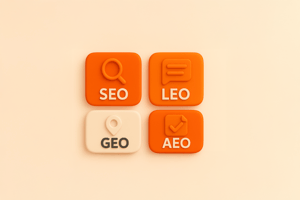
Conclusion & Outlook: Thinking About AI Visibility Holistically
Digital visibility is changing. Not radically, but noticeably. It is not the technical foundations that are outdated, but the way content is processed and distributed today. Especially in the B2B sector, where information processes are more complex, it becomes clear: the right content only achieves its goal if it can also be understood by machines.
This is where the four central approaches to modern visibility come into play: SEO, LEO, GEO, and AEO. They are not opposites but rather complementary layers that together ensure that content appears where decisions are prepared today, not only in search engines but also in AI systems, chatbots, voice assistants, and generative platforms such as ChatGPT, Perplexity, Google SGE, or Gemini.
SEO: The proven foundation
Technically clean websites with clear structure, sensible internal linking, mobile optimization, and fast loading times remain the basis. High-quality, well-researched, strategically developed content also retains its importance. SEO remains relevant, especially in B2B, but it is no longer enough to optimize solely for crawlers.
LEO: Content that is understood
Language Engine Optimization ensures that content is not only visible but also usable. Large language models like GPT-4, Gemini, or Claude do not read websites from top to bottom. They capture paragraphs, identify patterns, and build answers from them. What matters is whether content is clearly structured, linguistically precise, and understandable on its own, even without additional context. For complex products or technical services, this is a key factor for citation and reach. Gemini in particular analyzes content across contexts and links text signals with structured data sources to generate reliable answers.
GEO: Visibility in generative search systems
Generative Engine Optimization makes content discoverable in systems like Google SGE or Perplexity. These AI-driven search experiences work differently from classic SERPs. They do not rely on rankings but on structure. GEO emphasizes semantic clarity, machine-readable data, descriptive headings, and content with genuine informational value. Google SGE decides based on context, authority, and data structure which information to include in an AI overview. Especially for B2B sites with complex services or regional focus, this creates new and direct opportunities for visibility.
AEO: Antwortfähig sein
Answer Engine Optimization shifts the focus from clicks to direct answers. Systems such as Siri, Bing Copilot, ChatGPT, or Gemini use content that is clearly structured, well-formulated, and technically marked up. Companies that provide targeted answers, for example in the form of FAQs, how-to guides, or advisory texts, are far more likely to be included by these systems. The chance of having individual passages appear in a Gemini answer or an SGE panel increases significantly when content is modular and contextually clear.
Stronger together: Why integration matters
In B2B marketing, the goal is not reach at any cost, but relevance, trust, and timing. This is exactly what the four visibility approaches achieve when combined. SEO provides the technical foundation and stability. LEO ensures that content is understood by machines. GEO positions it in new generative interfaces. AEO delivers precise answers at the right moment, through systems such as Gemini or Siri.
The goal is not to discard what has worked before. On the contrary. It is about adapting existing strategies to new information pathways. The content remains, but the structure becomes smarter. Keywords give way to context, paragraphs are conceived as modular, and data is deliberately marked up.
Outlook: What this means for your visibility
For many companies this does not mean a complete rebuild, but rather the targeted further development of existing content. A well-structured FAQ, a revised product section, or a clearly organized knowledge page can make all the difference today. Visibility is not disappearing, it is shifting in form.
Tools like Gemini, Google SGE, and ChatGPT decide in real time which content they include. Those who do not deliver in machine-readable form remain invisible, even if their content is high-quality.
This blog series has laid the foundation. The next step is to apply these principles to your content, not as a short-term trend but as a sustainable strategy for digital visibility in the age of AI. For a practical example of how such technologies can be integrated into daily work, see our article on “Boosting Productivity with AI in Phone Communication,” which explores the combination of language models and customer interaction.
If you want to find out whether your content is already AEO- or LEO-ready, or how existing pages can be optimized for GEO and SEO, we are happy to discuss this with you.
Visibility today means providing answers, not just being found.
FAQ
